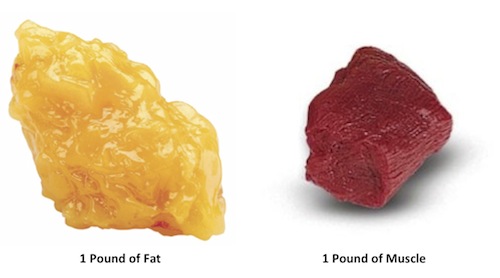In this new era of exercise and fitness, there are countless old myths floating around that just won’t go away. One of the most widespread is the notion that strength training turns fat into muscle and that if you stop this type of training your muscles will turn into fat. This is totally untrue, as muscle and fat are two totally different types of tissue that also function differently.
Muscle and fat are two totally different types of tissue that also function differently.
Tackling the Old Myth
Over 50% of the body is comprised of muscle tissue (muscle mass), which contributes to the body’s shape and form. Connective tissue anchors muscle tissue to the skin. When muscle is well developed, the surrounding skin tightens. However, if this tissue is not developed or even maintained the skin becomes loose and flabby.

Strength training is critical for maintaining muscle mass and it can also lead to significant gains in muscle hypertrophy, especially when you lift with relatively heavy loads. Muscle hypertrophy is basically an increase in muscle size. Failing to perform strength training on a regular basis will cause your muscles to shrink in size and become weak.
Related Article: 5 Reasons Why Resistance Training Is Necessary for Weight Loss
Failing to perform strength training on a regular basis will cause your muscles to shrink in size and become weak.
This shrinking and weakening of muscle is termed atrophy. Atrophied muscles are in essence what make you look and feel fatter.
Now, fat tissue (fat mass) is packed in between skin and muscle tissue. When there is an excess of fat growth during weight gain, the skin stretches in order to accommodate it. After weight loss has occurred the skin that once surrounded the fat tissue remains stretched giving it a loose, flabby appearance.
This problem is amplified when strength training is not performed to preserve muscle tissue during weight loss. Hence the reason why people believe their muscles will turn into fat if they don’t strength train.
Related Article: How to Lose Weight Without Getting Flabby Skin
In addition to muscle atrophy and flabby skin, failing to perform strength training will lead to gains in fat mass.
This happens because your metabolic rate (the rate at which you burn calories) is highly contingent on your levels of muscle mass. If you’re not preserving your muscle mass with regular strength training, your metabolic rate will decrease as will the amount of daily calories you burn.
Ultimately, these effects can cause excess weight gain in the form of fat.
Related Article: The Important Role of Metabolism in Weight Loss
If you’re not preserving your muscle mass with regular strength training, your metabolic rate will decrease as will the amount of daily calories you burn.
What You Can Do About It
To ensure you don’t get “fat” by way of muscle atrophy or reductions in your metabolic rate, it’s important that you perform strength training exercises for all your major muscle groups at least 2-3 days each week. You should do this whether you’re trying to lose weight, gain it, or maintain it.
My book outlines specific strategies for choosing the right exercises to meet your needs. I also include detailed training programs that you can implement today.
In general, if you’re trying to lose weight, it’s important to combine your strength training with a sufficient amount of cardiovascular (cardio) exercise. As you lose fat with cardio, the well-sculpted muscles you develop with strength training will neatly fill out the space that was once occupied by the fat.
This is a good thing as it greatly eliminates the appearance of body flab during weight loss.
Related Article: How to Lift Weights Without Bulking Up
On the flip side, when you’re trying to gain weight, strength training ensures you’re putting on muscle mass as opposed to fat mass. Plain and simple. Finally, when you’re trying to maintain your weight, strength training will help to preserve your muscle mass and, ultimately, your metabolic rate while keeping your body in good form and shape.
Now, it doesn’t stop there!
Be sure you’re consuming a well-balanced diet with adequate amounts of protein from fish and seafood, poultry, lean meats, low-fat dairy foods and/or high-quality soy products in order to fuel muscle development. It’s also important to include other nutrient-dense foods like vegetables, fruit, legumes, whole-grain foods, and healthy fats in your daily eating regimen for overall good health.
Related Article: A Simple Guide to Eating Sensibly
Muscle atrophy and a sluggish metabolism will make you “fatter” and flabby skin will make it look worse.
So there you have it! The debunking of that old muscle turns to fat myth.
In addition to the mere act of eating too much and doing to little, muscle atrophy and a sluggish metabolism will make you “fatter” and flabby skin will make it look worse. Although these changes in the body are linked to strength training, or a lack therefore, the processes by which these changes occur within muscle and fat tissue are totally different.






